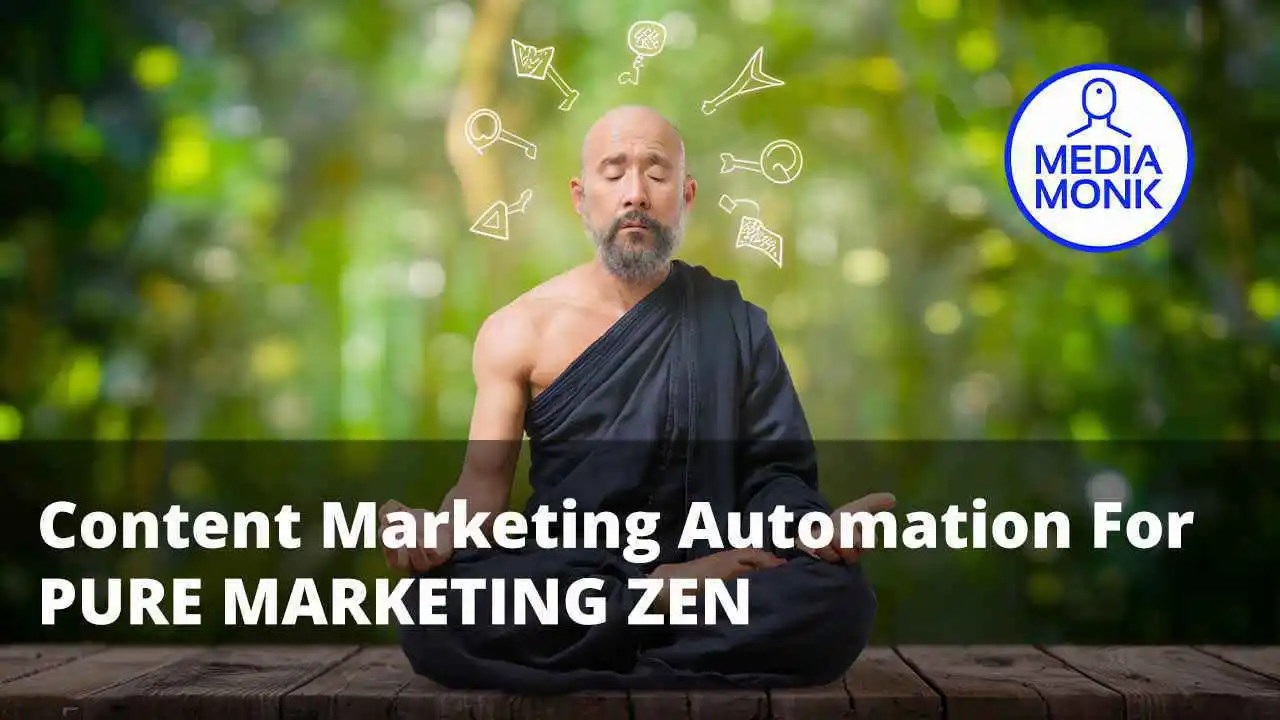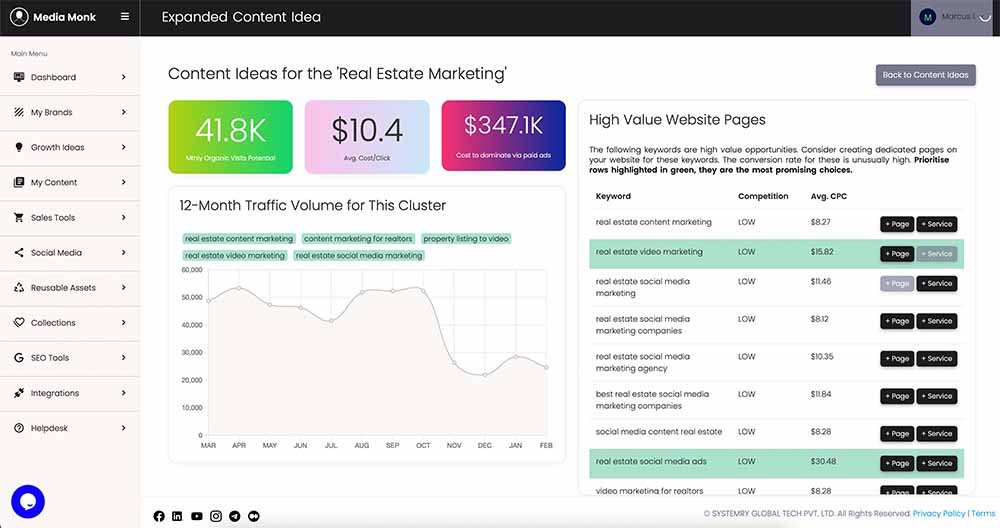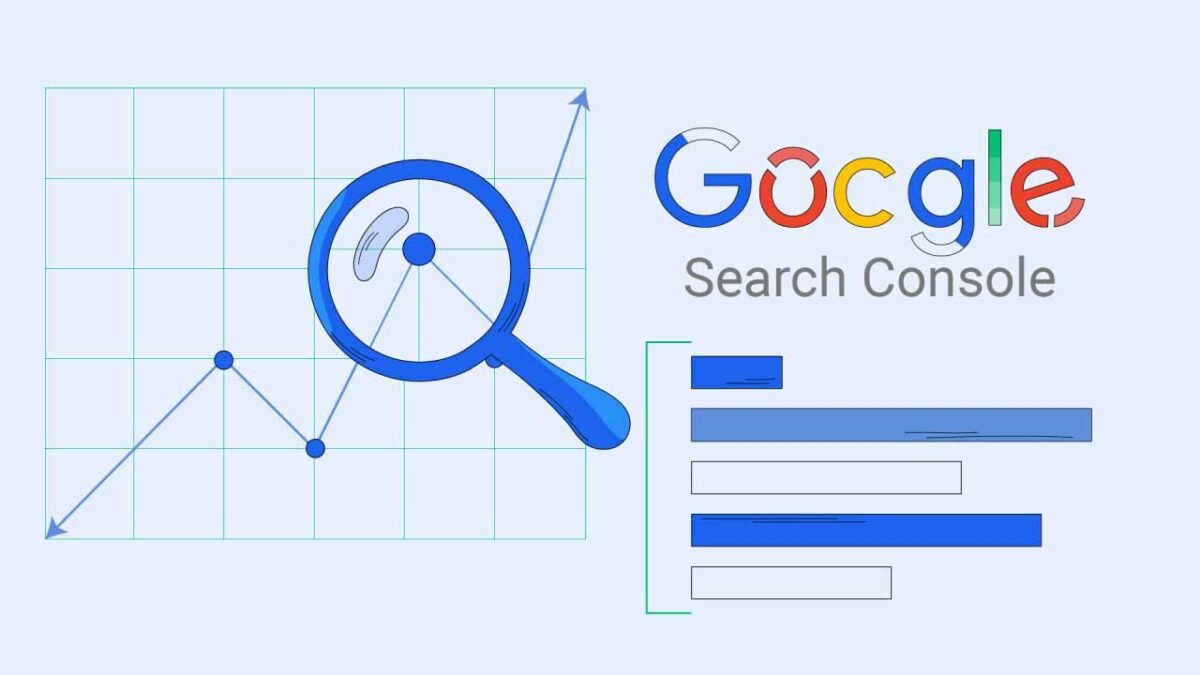
Table of Contents
In today’s fast-paced digital landscape, content marketing automation stands as a beacon for efficiency, allowing brands to maintain a consistent online presence without the constant manual effort. Media Monk emerges as a powerful ally in this domain, offering a suite of tools designed to streamline content planning, creation, automation, and distribution. Here’s how to leverage Media Monk to automate your content marketing strategy in five easy steps:
Content Marketing Automation Setup: SEO Keywords Tool for Strategic Planning
Media Monk’s SEO Keywords Tool is engineered to sift through vast datasets, identifying not only the keywords with significant search volume but also those niche-specific, long-tail keywords that often go unnoticed. These long-tail keywords are particularly valuable because they cater to specific queries, indicating a higher intent from the searcher. The inclusion of LSI keywords further refines this process, offering terms semantically related to your primary keywords. This nuanced approach ensures that the content you plan and produce is comprehensive and contextually rich, catering to a broad spectrum of search queries related to your field.

Crafting a Data-Driven Content Strategy:
Keyword Identification and Clustering: Begin by using the SEO Keywords Tool to generate a list of relevant keywords, including both high-volume and long-tail variants. Cluster these keywords based on thematic relevance to outline distinct content pillars for your strategy. This clustering not only aids in organizing your content calendar but also in developing a website structure that search engines can easily navigate and index.
User Intent Mapping: Dive deeper into each keyword cluster to understand the user intent behind these searches. Categorize them based on the nature of the intent – informational, navigational, transactional, or commercial investigation. This understanding allows you to tailor your content to meet the specific needs and stages of the buyer’s journey, enhancing user engagement and conversion potential.
Gap Analysis: The SEO Keywords Tool also plays a pivotal role in identifying content gaps within your current strategy. By comparing your existing content against the keyword clusters and user intent, you can pinpoint areas of opportunity where additional content can drive value and engagement. This gap analysis is instrumental in continuously refining and expanding your content universe to cover broader aspects of your domain.
Competitive Analysis: Leverage the tool to conduct a competitive analysis, understanding the keyword strategies employed by your competitors. Identify keywords they rank for that you don’t, and assess the quality of content backing those rankings. This insight can guide you to create superior content that competes effectively, capturing a larger share of organic traffic.
Continuous Optimization: With the dynamic nature of SEO, it’s crucial to regularly revisit your keyword strategy using the SEO Keywords Tool. Search trends, user behavior, and competitive landscapes evolve, necessitating adjustments to your content plan to maintain and enhance its effectiveness.
Implementing Your Strategy:
Armed with a comprehensive, data-backed content strategy, you’re positioned to automate the content creation process effectively. By ensuring each piece of content is rooted in strategic keyword insights, you maximize its reach and relevance, driving significant SEO and engagement outcomes. Remember, the success of content marketing automation hinges on the precision of your planning phase. Media Monk’s SEO Keywords Tool is your ally in this endeavor, offering the insights needed to craft a content strategy that resonates deeply with both your audience and search engines.
Utilize the Google Search Console (GSC) Data Tool for Insight-Driven Optimization
Utilizing Media Monk’s Google Search Console (GSC) Data Tool for insight-driven optimization represents a strategic pivot towards a more informed and effective content marketing approach. This powerful tool offers a window into the performance of your content in the vast landscape of search engines, presenting a detailed analysis of search traffic, ranking positions, and click-through rates (CTRs). Such insights are not just metrics; they are the guiding stars for optimizing your content to better serve your audience and enhance your SEO footprint.

Deep Dive into Search Performance:
The GSC Data Tool dissects your website’s search performance, providing granular details on how individual pages rank for specific queries. This level of detail allows you to understand which pieces of content are performing well, which are underperforming, and, crucially, the reasons why. For instance, high-ranking pages with low CTRs might indicate a mismatch between the content and user intent or poorly crafted meta titles and descriptions.
Identifying Content Opportunities:
One of the tool’s most potent capabilities is its ability to highlight content opportunities through gap analysis. By cross-referencing your site’s content with search data, Media Monk’s tool can identify topics that your target audience is interested in but that your site currently doesn’t address adequately. This insight is invaluable for staying ahead of market trends and ensuring that your content strategy remains aligned with user demand.
Optimization Beyond Keywords:
While traditional SEO focuses heavily on keywords, the GSC Data Tool encourages a broader perspective. It considers factors like the freshness of content, user engagement signals, and the competitive landscape. This holistic view ensures that optimization efforts extend beyond mere keyword inclusion to encompass content quality, user experience, and relevance—all critical factors in modern SEO.
Strategic Content Refreshing:
The tool’s insights into content performance over time are instrumental in identifying candidates for updating and refreshing. Content that has lost its search position over time due to emerging competition or changing search trends can be revitalized with updated information, better alignment with current search intent, or enhanced with multimedia elements to improve engagement and reclaim lost visibility.
Enhancing User Engagement:
By analyzing pages that have high impressions but low click-through rates, the GSC Data Tool helps pinpoint areas where user engagement can be improved. This might involve rewriting meta descriptions to be more compelling, improving content readability, or adjusting the content’s structure to better address user questions. Enhancing user engagement not only improves SEO rankings but also increases the likelihood of conversions.
Competitive Benchmarking:
Understanding your content’s performance in the context of the broader competitive landscape is crucial for strategic positioning. The GSC Data Tool allows you to benchmark your content against industry standards, identifying areas where competitors may have an edge and uncovering strategies to differentiate your content and capture additional market share.
Actionable Insights for Continuous Improvement:
Armed with the insights from Media Monk’s GSC Data Tool, marketers and content creators can implement targeted optimizations to existing content, plan new content with confidence, and continuously refine their content strategy based on actual performance data. This cycle of measurement, analysis, and optimization is key to driving sustained growth in search visibility and audience engagement.
In essence, the GSC Data Tool by Media Monk transforms raw data into a strategic asset, enabling businesses to craft a content strategy that is both responsive to audience needs and anticipatory of market trends. It’s a tool not just for optimization, but for continuous strategic evolution in the ever-changing landscape of search engine marketing.
Craft Your Content Plan with the Content Planner
The Content Planner within Media Monk is not merely a tool; it’s the linchpin of a sophisticated content marketing strategy, designed to harmonize the creation, scheduling, and publication of content across various platforms. By centralizing the orchestration of your content efforts, the Content Planner transforms the chaotic nature of content marketing into a streamlined, coherent process, enabling businesses to deliver a consistent and engaging narrative to their audience.

Strategic Content Visualization:
One of the key features of the Content Planner is its ability to provide a macroscopic view of your content strategy over selectable time frames—be it days, weeks, or months. This high-level perspective is crucial for identifying patterns in content distribution, ensuring a balanced mix of topics, formats, and themes. By visualizing your content strategy, you can avoid thematic saturation or neglect, maintaining a healthy diversity that keeps your audience engaged and receptive.
Integrated Platform Management:
In today’s digital landscape, a multi-platform presence is non-negotiable. However, managing content across different channels can be a logistical nightmare. The Content Planner addresses this challenge by integrating content scheduling for various platforms into one interface. Whether it’s blog posts for your website, tweets, LinkedIn articles, or Facebook posts, the planner ensures that your content narrative is cohesive and consistent across all channels.
Efficiency Through Automation:
Automation lies at the heart of the Content Planner. By allowing for the scheduling of content creation and publication, the tool eliminates the need for daily manual oversight, freeing up valuable time for content strategists and creators to focus on ideation and quality assurance. The automation feature also ensures that content goes live at the most opportune times, maximizing visibility and engagement without constant human intervention.
Customizable Workflow Integration:
Every business has unique content needs and workflows. The Content Planner’s customizable features enable you to tailor the tool to fit your specific processes. Whether it’s setting reminders for content review, integrating approval workflows, or organizing content by campaign, the planner adapts to your operational style, making it an invaluable asset for teams of all sizes.
Data-Driven Content Decisions:
The integration of Media Monk’s SEO Keywords Tool and GSC Data Tool with the Content Planner allows for a data-driven approach to content scheduling. Insights from these tools can inform the timing, topic, and platform choice for each piece of content, ensuring that your content plan is not only strategic but also backed by empirical data. This symbiotic relationship between tools within Media Monk creates a feedback loop that continuously refines your content strategy for optimal performance.
Collaboration and Transparency:
In environments where multiple stakeholders are involved in content creation and approval, the Content Planner promotes transparency and collaboration. It provides a shared view of the content calendar, enabling team members to contribute, review, and provide feedback on upcoming content. This collaborative approach ensures alignment with brand messaging and strategy, while also fostering a culture of creativity and shared ownership over content outcomes.
In summary, the Content Planner within Media Monk empowers businesses to take control of their content marketing strategy with precision and foresight. It transforms the complex ecosystem of content creation, scheduling, and publication into a manageable and scalable operation. With its comprehensive features and integrations, the Content Planner is more than a tool—it’s a strategic partner in crafting a content marketing strategy that delivers results.
Automate Content Production on a Schedule
Media Monk’s approach to automating content production revolutionizes the way businesses handle their content strategies. By leveraging this powerful feature, organizations can ensure a consistent flow of content, meticulously aligned with their marketing calendar, without the constant manual input traditionally required. This automation is designed to work on a predefined schedule, enabling businesses to plan ahead and ensure that their content pipeline is never interrupted. Yet, crucially, Media Monk integrates a crucial checkpoint into the process: content isn’t autoposted until it receives final approval. This dual approach marries efficiency with control, ensuring that while the process is streamlined, the quality and relevance of content are never compromised.

Strategic Scheduling and Planning:
At the heart of this feature lies the ability to strategically schedule content production well in advance. Whether it’s blog posts, social media updates, or email newsletters, Media Monk’s automation tools allow you to set up a content calendar that automatically triggers content creation at predetermined intervals. This forward-looking planning capability ensures that your content strategy aligns with key dates, product launches, or industry events, maximizing the impact of your content.
Maintaining Editorial Control:
While automation brings undeniable efficiency benefits, the integrity of your brand voice and the quality of the content are paramount. Media Monk’s requirement for final approval before autoposting safeguards these aspects. This step serves as a quality checkpoint, where content can be reviewed, refined, and optimized to meet your standards. It allows for the integration of last-minute insights or adjustments based on evolving market dynamics, ensuring that your content remains relevant and impactful.
Customization and Flexibility:
Media Monk’s content production automation is built with customization at its core. You can tailor the scheduling, frequency, and type of content to match your specific marketing goals and audience preferences. This flexibility means that whether your focus is on driving engagement, generating leads, or building brand awareness, the automation tools can be configured to support your objectives. Furthermore, the system’s adaptability allows you to adjust your content strategy in response to performance analytics, audience feedback, or shifts in your marketing priorities.
Seamless Integration with Content Planning:
The automation of content production is seamlessly integrated with the Content Planner, offering a cohesive and comprehensive view of your content strategy. This integration enables a synergistic workflow where automated content production feeds directly into your overall content calendar. It ensures that every piece of content, whether produced manually or through automation, is accounted for, scheduled appropriately, and aligned with your broader marketing strategy.
Efficiency Without Sacrificing Creativity:
One of the significant advantages of automating content production is the liberation of creative resources. By automating routine content creation tasks, marketing teams can redirect their focus towards strategic thinking, creative ideation, and high-value projects. This shift away from operational tasks allows for a deeper exploration of innovative content formats, experimentation with new marketing channels, and the cultivation of a more dynamic and engaging brand narrative.
In essence, Media Monk’s automation capabilities transform the content production landscape, offering businesses the tools to maintain a dynamic and consistent content strategy at scale. By balancing automation with editorial control, Media Monk ensures that businesses can enjoy the benefits of efficiency without compromising on the quality or strategic alignment of their content. This approach not only streamlines content marketing efforts but also amplifies their effectiveness, driving better engagement, reach, and ultimately, business results.
Monitor and Adjust Your Strategy Based on Performance
The final and perhaps most critical step in the content marketing automation process facilitated by Media Monk is the continuous cycle of monitoring and adjustment. This process is not just about setting a content strategy in motion; it’s about fine-tuning it to perfection over time. Media Monk’s comprehensive analytics tools are designed to provide deep insights into how your content performs across various platforms, giving you the data you need to make informed decisions about your content strategy.

Deep-Dive into Analytics:
Media Monk’s analytics go beyond surface-level metrics, offering a granular view of how each piece of content resonates with your audience. From engagement rates, shares, and comments to more sophisticated metrics like conversion rates and time spent on page, these analytics paint a detailed picture of content performance. By understanding which types of content drive the most engagement or lead to conversions, you can begin to uncover the preferences and behaviors of your target audience.
Identifying Patterns and Trends:
Over time, a careful analysis of these metrics will reveal patterns and trends that can inform your content strategy. Perhaps how-to guides consistently outperform other types of content, or maybe posts published on Tuesdays receive more engagement than those published on Fridays. Recognizing these trends allows you to adjust your content plan to leverage these insights, optimizing for the formats, topics, and publishing times that yield the best results.
Content Experimentation:
Armed with Media Monk’s analytics, brands can afford to experiment with new content types, topics, or distribution channels without flying blind. For example, if you’ve primarily focused on blog posts, analytics may encourage you to test the waters with video content or a new social media platform. By closely monitoring the performance of these experiments, you can quickly determine whether they’re worth further investment.
Adapting to Audience Feedback:
Analytics serve as a proxy for direct audience feedback, offering clues about what your audience enjoys and what they don’t. High bounce rates on certain types of content, for example, could indicate that it’s not meeting audience expectations, signaling a need for adjustment. Similarly, high engagement rates can validate your content direction, encouraging you to double down on what works.
Competitive Benchmarking:
Understanding your content’s performance in isolation is valuable, but comparing it against industry benchmarks or competitors can provide additional context. Media Monk’s analytics allow you to see how your content stacks up against the wider market, helping you identify areas for improvement and opportunities to outshine your competition.
Actionable Insights for Strategy Refinement:
Ultimately, the power of Media Monk’s analytics lies in its ability to transform data into actionable insights. Regular reviews of content performance can inform not just immediate adjustments but also long-term strategic shifts. Perhaps the data shows a growing interest in a topic you’ve only tangentially covered, suggesting a potential area for expansion. Or maybe it reveals that a once-popular content format is declining in effectiveness, signaling a need to innovate.
Incorporating these insights back into your content planning and automation process closes the loop on a dynamic and responsive content marketing strategy. By making monitoring and adjustment an ongoing practice, businesses can ensure that their content marketing efforts remain aligned with audience preferences, market trends, and business objectives. Media Monk facilitates this continuous cycle of improvement, enabling brands to not just compete but excel in the ever-evolving digital landscape.
Conclusion
Setting up content marketing automation with Media Monk transforms a daunting task into a manageable and strategic process. By leveraging the suite of tools provided—SEO Keywords Tool, GSC Data Tool, Content Planner, and automated content production—you can ensure that your content strategy is not only efficient but also effective. Remember, the goal of automation is to free up time to focus on creative and strategic tasks, not to replace the human touch that makes your content resonate with your audience.


